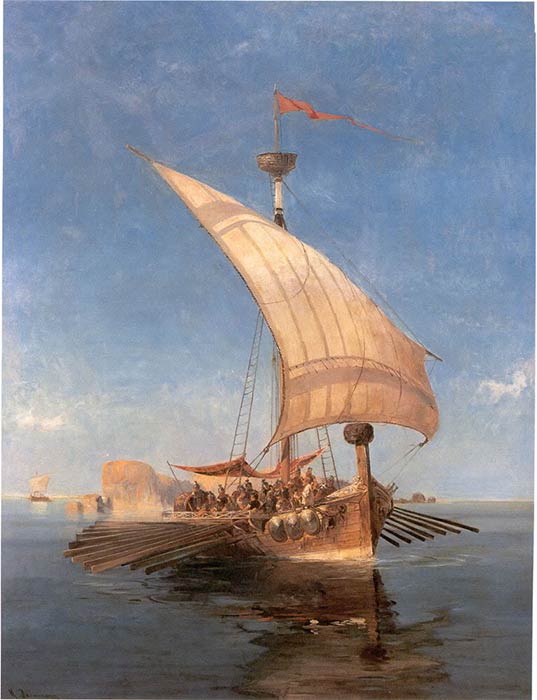Clues To King Alcinous’ Scheria: The Lost Sickle In The Sea
The mythological Alcinous and the location of his kingdom of the Phaeacians have remained one of the most elusive topics of ancient Greek literature. Clues to the ruler and his kingdom survive only in the narratives of the journeys of Odysseus and Jason. Was there an Alcinous prototype ruling over a foreign nation of master seafarers? Apollonius in Argonautica directs one to Drepane in the Ceraunian sea; Apollodorus in Library points to Corcyra (Korfu) as the island of the Phaeacians; Homer in the Odyssey only writes that Odysseus washed ashore on Scheria, and that the Phaeacians had fled from Hypereia where they were under attack from the Cyclopes. How much evidence can the ancient narratives provide, and how much of it can be corroborated by archaeology, geography and paleontology?

The Argo, by Konstantinos Volanakis (1837–1907) (Public Domain)
Clues From The Odyssey And Argonautica
In every source, it is said Alcinous was not a native to Greece but instead a ruler of the peoples known as the Phaeacians, living in the outskirts of what then was the known world. He was a wise and just leader; favored by both gods and man. He is first and formally introduced in the eighth century BC epic, Homer’s the Odyssey. King Alcinous also plays an important role in the third century BC Apollonius Rhodius’ Argonautica. Although this script post-dates Homer by at least half a millennium, Homer and his audience were well aware of the exploits of Jason and the Argonautic myth. The Argonauts were a band of heroes in ancient Greek mythology who accompany Jason to Colchis in his quest to find the Golden Fleece on their ship, the Argo. They are said to predate the Trojan War. This becomes clearer in the episode in the Odyssey where Circe gives Odysseus instructions on how to continue his voyage home and where she begins to speak of the Planctae (or the Wandering Rocks) stating the following: “ One seafaring ship alone has passed by those, that Argo famed of all, on her voyage from Aeetes, and even her the wave would speedily have dashed there against the great crags, had not Hera sent her through because Jason was dear to her”.

Circe and Odysseus, by Matthijs Naiveu (1702) (Public Domain)
It should also be noted that Circe was the sister of King Aeetes of Cholchis. Aside from the Planctae, other themes from the Odyssey can be found in the Argonautica which include the sirens.
Like this Preview and want to read on? You can! JOIN US THERE ( with easy, instant access ) and see what you’re missing!! All Premium articles are available in full, with immediate access.
For the price of a cup of coffee, you get this and all the other great benefits at Ancient Origins Premium. And - each time you support AO Premium, you support independent thought and writing.
By profession, Petros Koutoupis is a software developer and an entrepreneur. When not overwhelmed with being a good husband and an excellent father (of two), and during the little free time he may have, Petros enjoys immersing himself with topics of ancient history and theology. He is fluent in the language of Greek, and has been a self-taught student of Septuagintal Greek and Biblical Hebrew; with additional knowledge in Aramaic, Ugaritic, and Akkadian grammar. His recent work focuses predominantly on the Late Bronze and Early Iron Ages of Eastern Mediterranean, leading to a quest to unravel the mysteries of our history.
Top Image: Odysseus at the Court of Alcinous (1814-1816) by Francesco Hayez (Public Domain)




















Comments
Hi All,
It took a while but, I did say that if I thought of something further regarding this Subject I'd come back and share it.
Sea faring People come up a lot in The Bible; such as The Philistines as an example, however, A Bible Study came up on The Prophet's of The Bible and there are numerous descriptions of Sea Faring People whose sole Economy is through commerce and trade on the High Seas.
An the People had a King over Them.
The Geographic Site in The Bible is said to be Tyre. Reading Ezekiel chapter 28; God Himself mentions a King of Tyre with a lot of Power but, has earned the ire of God's Wrath upon him promising to destroy his thriving sea faring Kingdom.
The devestation would be so Great that it would astonish the Rest of the World altogether.
Considering God's pouring out judgement on the King of Tyre God is addressing The Power behind that King which is The Adversary considering how we're all scratching our collective Heads in trying to figure out where this place was exactly; I'm thinking Tyre Present Day Turkey.
This all I have on this Subject King Alcinous' Sickle at the moment so until next discussion Everyone Goodbye!
Hi All,
I've read two Jason versions of the Golden Fleece; Edith Hamilton, and Bulfinch's of course The Odyssey in all its entirety. Once thought them to be Myth's but, that's not the case anymore.
Would love to expand on why that is but, not this time around, so until next time, or unless I think of something else to share about this Topic Everyone, Goodbye!
the wandering rocks sounds like glaciers to me. I always wondered if the Golden Fleece myth was misplaced in the Black sea but rather somewhere in the North Atlantic.